The government’s attempt to control nightlife and prostitution required brothel owners to restrict their businesses within an official licensed quarter (yûkaku). The Yoshiwara licensed pleasure quarter was set apart from Edo society by its location on the northern edge of the city, and by its language and code of behaviour. The confined society within the Yoshiwara walls was a sort of prison to the prostitute or courtesan and her assistants while they served out their terms of contract, although occasionally her term of service might be bought out by a client wanting to marry her.
To the wealthy townsmen (chônin) or the numerous samurai (military aristocracy) serving their required attendance in Edo, the Yoshiwara was a place of escape, a ‘floating world’ where classes mixed and dreams seemed tangible. Its delights were described in guidebooks and celebrated in prints, literature and drama. The glamorous image of top-rank courtesans created an aura of appeal beyond simply sex for sale. It also distanced the Yoshiwara from unofficial brothel districts and more basic facilities around the city. If erotic prints depicted a courtesan it was usually with a secret lover rather than a client, but suggestion of possible romantic attachment was usually an illusion.
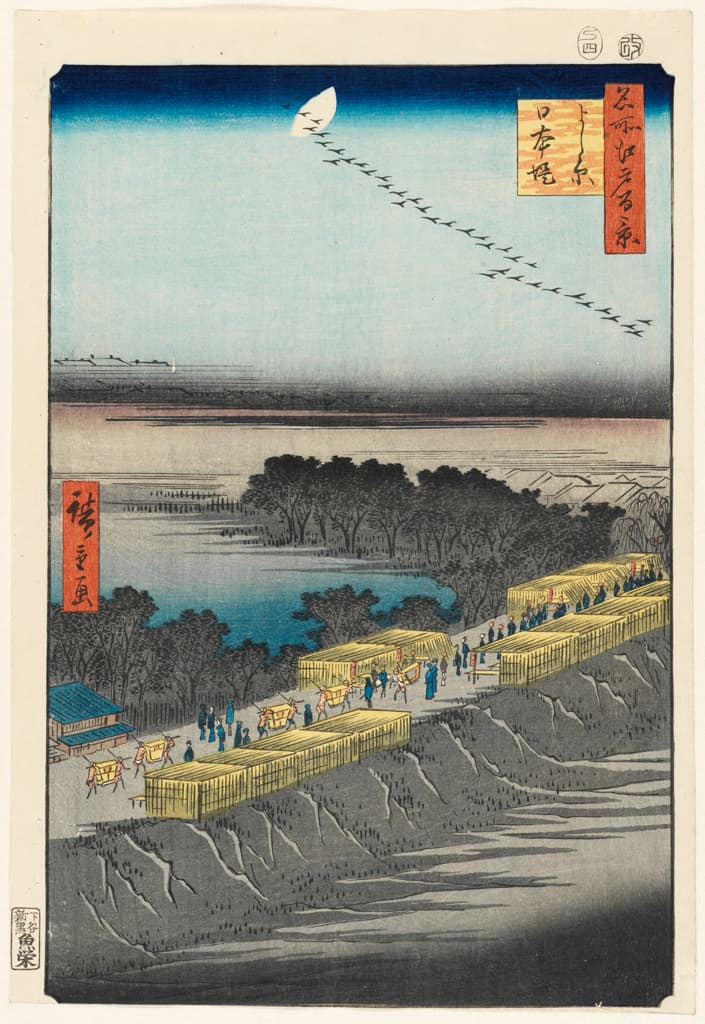
Nihon Embankment, Yoshiwara
Yoshiwara Nihonzutsumi
Utagawa Hiroshige
1797-1858
P.3577-R
Colour print from woodblocks. Ôban format. Publisher: Uoya Eikichi (Uoei). 04/1857.
Given by T. H. Riches 1913
No. 100 in the series ‘One hundred famous views of Edo’ (Meisho Edo hyakkei), in the section for Winter.
The mile-long Nihon Embankment, constructed in 1620, was the final stage in the journey of visitors to the Yoshiwara licensed pleasure quarter (yûkaku), which was situated among rice paddies to the north of the city. The Yoshiwara was moved here after a fire in 1657 at its original location near the centre of Edo. The roofs of the Yoshiwara can be seen at the end of the embankment beyond the ‘Looking-back Willow’ (Mikaeri Yanagi) which was situated at the top of the slope leading to the main gate; here parting guests would pause to take a lingering ‘look back’ at dawn, before making the trip back along the embankment.
Arriving by boat, or by foot through the theatre district, the visitor would hire a palanquin carried by bearers for the journey along the embankment, or would go on foot, concealing his identity beneath a dark hood, with cheek cover (hôkammuri-zukin). The route was lined with over 100 teahouses (hikite-chaya) where clients could make advance arrangements with the particular brothel advertised on the red lantern hanging outside.
In an alternative printing, probably earlier, there is an extra wisp of cloud, and green printed on the willow and on the near embankment.
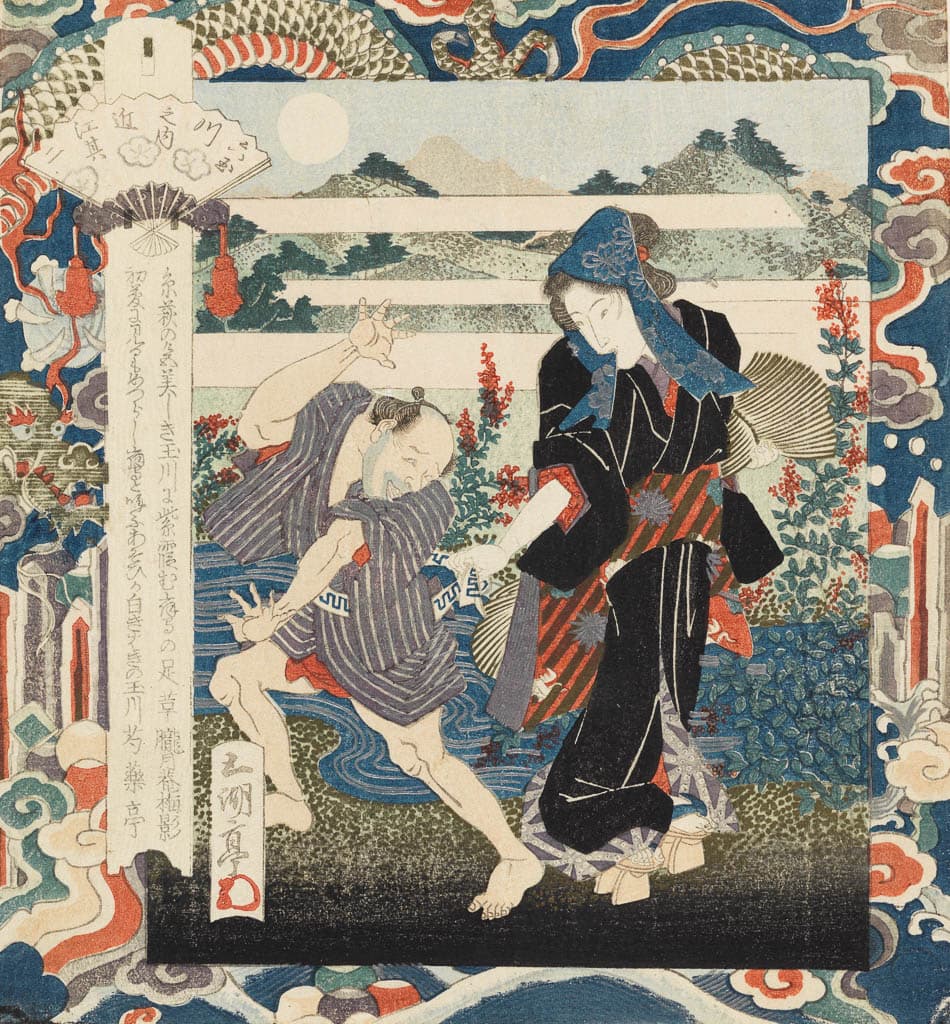
Ômi number two
Ômi sono ni
Utagawa Sadakage
c.1818-44
P.548-1937
Colour print from woodblocks, with metallic pigment and blind embossing (karazuri). Shikishiban format surimono. c.1832.
Given by E. Evelyn Barron 1937
From the series of surimono ‘Six Jewel Rivers’ (Mu Tamagawa no uchi). Surimono - literally ‘printed thing’ - was the name given to privately commissioned prints with special printing effects, usually made for and distributed by poetry groups or to celebrate particular occasions.
Here a low-class prostitute, or yotaka (literally ‘night hawk’) tries to lure a low ranking samurai retainer (yakko) by tugging at his sash. She carries a straw mat so that she can provide her services under the stars. The first poem on the print puns on the word tak_a, literally ‘hawk’, and _yotaka, ‘nighthawk prostitute’. The last line meaning the strings attached to a hawk while hunting (Taka no ashigawa) can also mean the strap by which a samurai attaches his dagger to his sash. The second poem plays on the convention of seeing a hawk in a New Year’s dream, but here the hawk is the prostitute.
Along the Jewel River,
with bush clover
so brilliantly coloured,
purple mist covers the hawks,
with strings tied to their feet.
– Rôgetsuan Umekage
In a New Year’s dream
it’s strange to see
a ‘hawk’ streetwalker,
with pale legs white as clover
along the Jewel River.
– Shakuyakutei
(translations: John T. Carpenter)
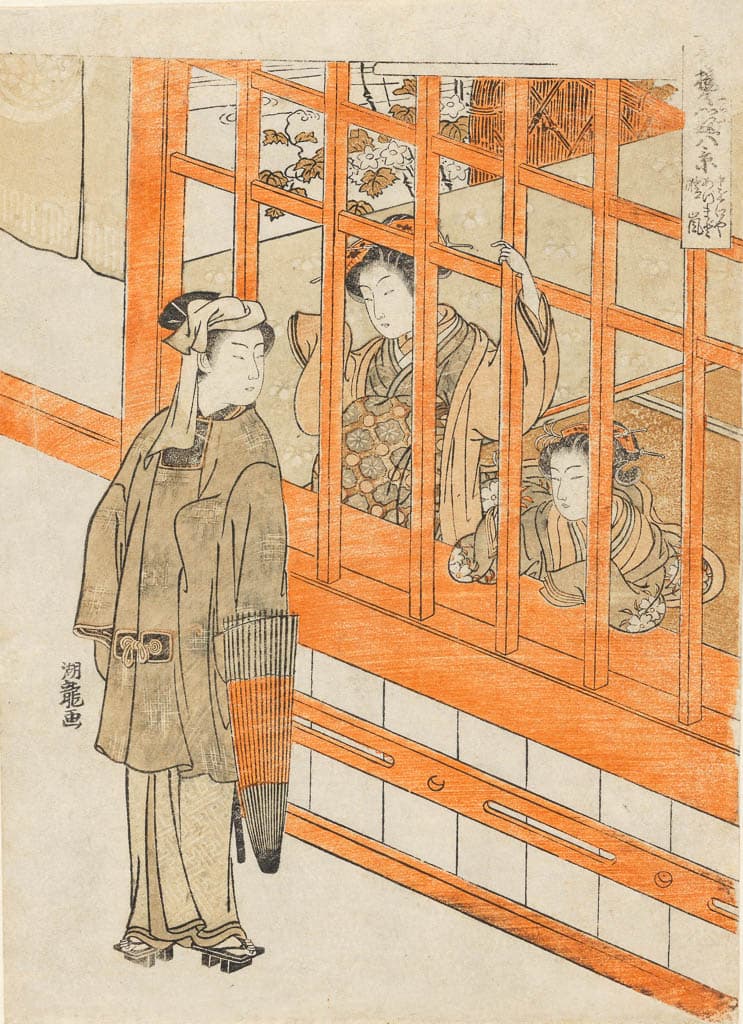
Azumado of the Nakaômiya: clearing storm
Nakaômiya Azumado seiran
Isoda Koryûsai
active 1766-88
P.3643-R
Colour print from woodblocks. Chûban format. c.1774.
Given by T. H. Riches 1913
From the series ‘Eight views of famous women of the green houses’ (Seirô meifu hakkei). The idea of sets of eight views (hakkei) derived from a traditional set of eight views of Ômi Province, north-east of Kyoto. Print designers usually substituted other settings, but always with associated moods carried over from the original set. This set gives us ‘views’ of the most famous beauties working in leading brothels of the licensed pleasure quarter, the Yoshiwara.
On the left of the latticed display room (harimise) is the entrance to the Nakaômiya brothel. Azumado’s sash (obi) is tied in front (this distinguishes her as a prostitute from other women, such as geisha, who tied it behind). It is decorated with the Nakaômiya’s trademark lattice-and-flower pattern. She and her attendant peer through the bars at a young man in a Chinese-style jacket. High-ranking courtesans did not usually show themselves to passers-by in the display room. He is probably a potential client, but it may be that he and Azumado are already acquainted.
Sets of ‘eight views’ always included a ‘clearing storm’ scene, and the man’s folded umbrella and high clogs (geta) suggest the recent storm implied by the title. But perhaps there is also a suggestion of a passing emotional storm.
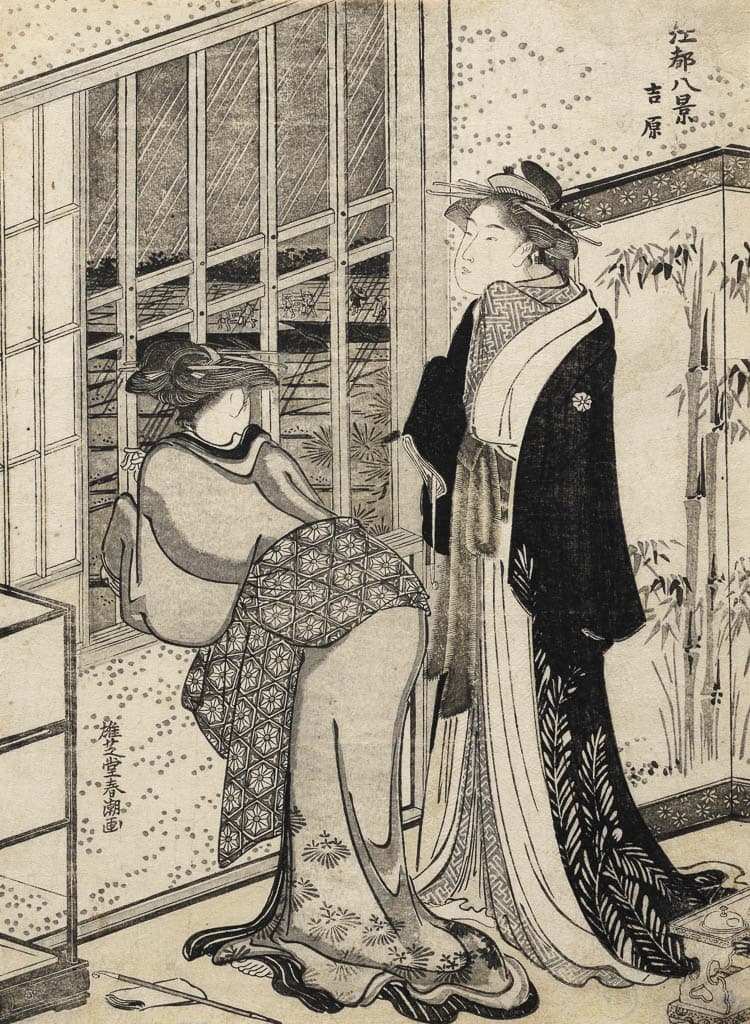
Yoshiwara Katsukawa Shunchô, active c.1781-1801
P.48-2010
Colour print from woodblocks (benigirai-e) with blind embossing (karazuri). Aiban format. 1780s.
Given by Israel Goldman in honour of Morton and Florence Goldman 2010
From the series ‘Eight Views of Edo’ (Edo hakkei). The idea of sets of eight views (hakkei) derived from a traditional set of eight views of Ômi Province, north-east of Kyoto’, itself derived from the Chinese series, ‘Eight views on the Xiao and Xiang Rivers’. Each view originally had an associated poem, with a mood or time of day. Print designers usually substituted other Japanese settings for the Ômi locations, but always with associated moods (or times of day) carried over from the original set. Sets of eight always included a scene of ‘night rain’, and in sets of Edo views, the ‘night rain’ usually featured the Yoshiwara.
Two courtesans gaze out at rain through the upstairs window of a Yoshiwara brothel. Distant figures make their way along the Nihon embankment linking the Yoshiwara to Edo, carried in covered palanquins or sheltered by umbrellas. The muted monochrome shading emphasises the deadening effect of rain, but rather than simply a picture of boredom during slack business, the image recalls the poetic association of rain and longing for a lover (with rain as metaphor for tears). The imagery also recalls love poems that play with the twin meaning of words for ‘gazing out pensively’ (nagame) and ‘long rains’ (naga-ame).
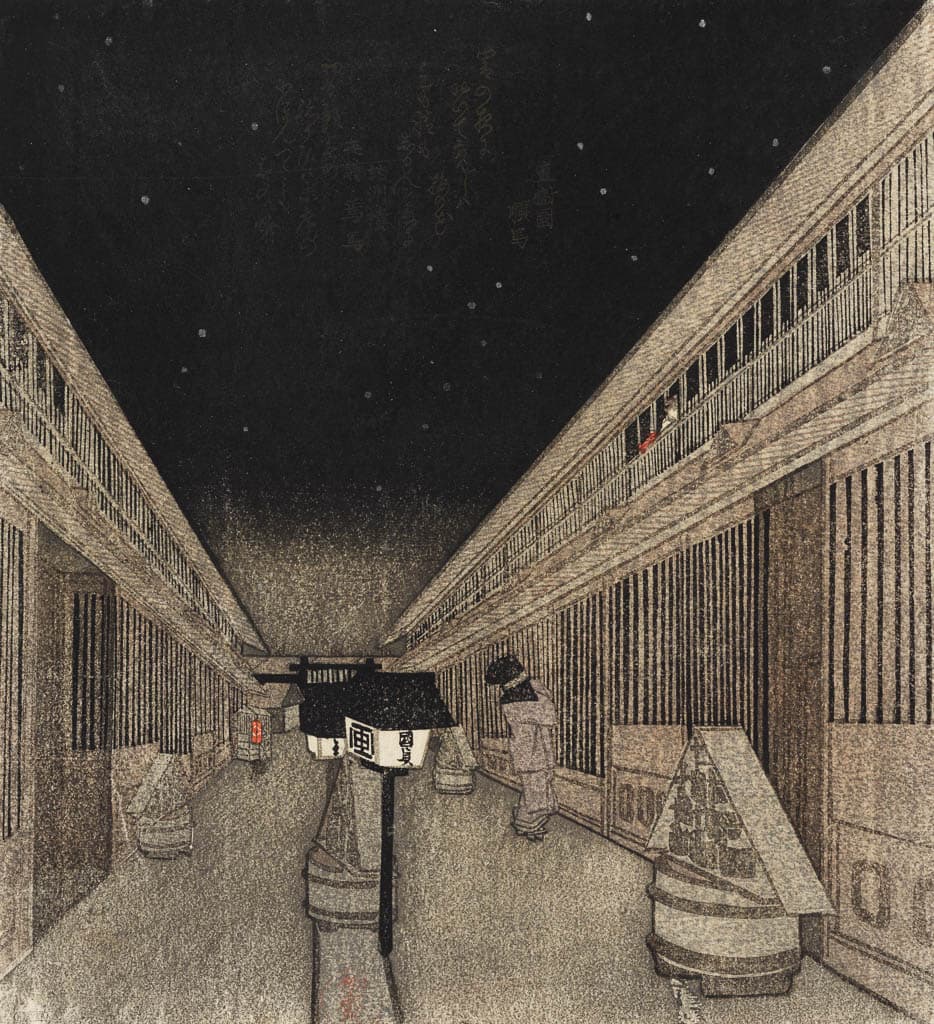
Yoshiwara street at night Utagawa Kunisada, 1786-1864
P.174-2007
Colour print from woodblocks, with metallic pigment, for the poem and white pigment for the stars. Shikishiban format surimono. Printer’s seal: Ryûsai Chimata (Inô Naojirô). Poet: Danjûrô Emba. c.1819.
Given by The Friends of the Fitzwilliam Museum 2007
This view shows the main street in the official Yoshiwara pleasure district at the first hint of dawn, with a departing customer conversing with a woman at an upper window, her face lit by the light of a lamp. He wears a black hood to disguise his identity as he leaves on his way to the Nihon Embankment, which separated the Yoshiwara from the city of Edo (Tokyo).
Kunisada’s signature appears on the street lamp. Kunisada adapted this design for the opening illustration in volume 2 of his first erotic book, Night parade of a hundred demons (Hyakki yagyô), in 1825.
The variant form of the name of the poet, Danjûrô Emba (1743-1822), suggests that the print may have been commissioned in his 77th year (1819), around the time other surimono by Kunisada were being printed by Inô Naojirô.




